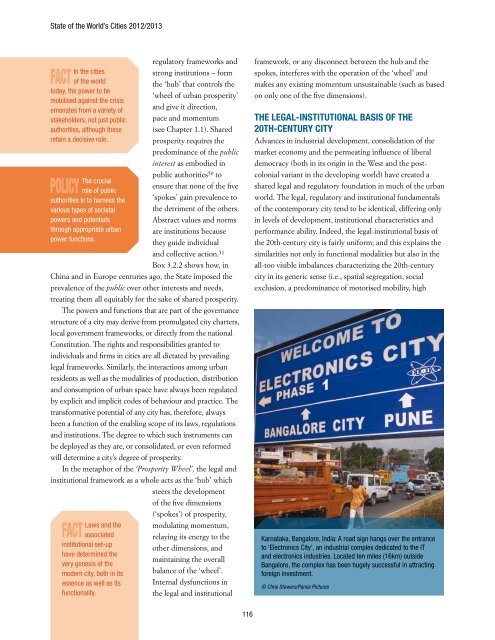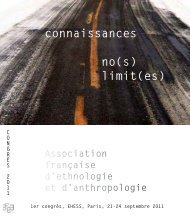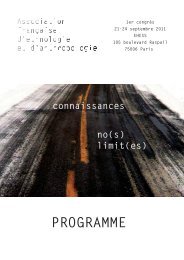state of the world's cities 2012/2013 - United Nations Sustainable ...
state of the world's cities 2012/2013 - United Nations Sustainable ...
state of the world's cities 2012/2013 - United Nations Sustainable ...
Create successful ePaper yourself
Turn your PDF publications into a flip-book with our unique Google optimized e-Paper software.
State <strong>of</strong> <strong>the</strong> World’s Cities <strong>2012</strong>/<strong>2013</strong>regulatory frameworks andIn <strong>the</strong> <strong>cities</strong>strong institutions – formfact <strong>of</strong> <strong>the</strong> world<strong>the</strong> ‘hub’ that controls <strong>the</strong>today, <strong>the</strong> power to be‘wheel <strong>of</strong> urban prosperity’mobilised against <strong>the</strong> crisisemanates from a variety <strong>of</strong>and give it direction,stakeholders, not just public pace and momentumauthorities, although <strong>the</strong>se (see Chapter 1.1). Sharedretain a decisive role.prosperity requires <strong>the</strong>predominance <strong>of</strong> <strong>the</strong> publicinterest as embodied inpublic authorities 50 toThe crucialensure that none <strong>of</strong> <strong>the</strong> fivepolicy role <strong>of</strong> publicauthorities is to harness <strong>the</strong> ‘spokes’ gain prevalence tovarious types <strong>of</strong> societal <strong>the</strong> detriment <strong>of</strong> <strong>the</strong> o<strong>the</strong>rs.powers and potentialsAbstract values and normsthrough appropriate urban are institutions becausepower functions.<strong>the</strong>y guide individualand collective action. 51Box 3.2.2 shows how, inChina and in Europe centuries ago, <strong>the</strong> State imposed <strong>the</strong>prevalence <strong>of</strong> <strong>the</strong> public over o<strong>the</strong>r interests and needs,treating <strong>the</strong>m all equitably for <strong>the</strong> sake <strong>of</strong> shared prosperity.The powers and functions that are part <strong>of</strong> <strong>the</strong> governancestructure <strong>of</strong> a city may derive from promulgated city charters,local government frameworks, or directly from <strong>the</strong> nationalConstitution. The rights and responsibilities granted toindividuals and firms in <strong>cities</strong> are all dictated by prevailinglegal frameworks. Similarly, <strong>the</strong> interactions among urbanresidents as well as <strong>the</strong> modalities <strong>of</strong> production, distributionand consumption <strong>of</strong> urban space have always been regulatedby explicit and implicit codes <strong>of</strong> behaviour and practice. Thetransformative potential <strong>of</strong> any city has, <strong>the</strong>refore, alwaysbeen a function <strong>of</strong> <strong>the</strong> enabling scope <strong>of</strong> its laws, regulationsand institutions. The degree to which such instruments canbe deployed as <strong>the</strong>y are, or consolidated, or even reformedwill determine a city’s degree <strong>of</strong> prosperity.In <strong>the</strong> metaphor <strong>of</strong> <strong>the</strong> ‘Prosperity Wheel’, <strong>the</strong> legal andinstitutional framework as a whole acts as <strong>the</strong> ‘hub’ whichsteers <strong>the</strong> development<strong>of</strong> <strong>the</strong> five dimensions(‘spokes’) <strong>of</strong> prosperity,Laws and <strong>the</strong> modulating momentum,fact associatedrelaying its energy to <strong>the</strong>institutional set-upo<strong>the</strong>r dimensions, andhave determined <strong>the</strong>maintaining <strong>the</strong> overallvery genesis <strong>of</strong> <strong>the</strong>modern city, both in its balance <strong>of</strong> <strong>the</strong> ‘wheel’.essence as well as its Internal dysfunctions infunctionality.<strong>the</strong> legal and institutionalframework, or any disconnect between <strong>the</strong> hub and <strong>the</strong>spokes, interferes with <strong>the</strong> operation <strong>of</strong> <strong>the</strong> ‘wheel’ andmakes any existing momentum unsustainable (such as basedon only one <strong>of</strong> <strong>the</strong> five dimensions).The Legal-Institutional Basis <strong>of</strong> <strong>the</strong>20th-Century CityAdvances in industrial development, consolidation <strong>of</strong> <strong>the</strong>market economy and <strong>the</strong> permeating influence <strong>of</strong> liberaldemocracy (both in its origin in <strong>the</strong> West and <strong>the</strong> postcolonialvariant in <strong>the</strong> developing world) have created ashared legal and regulatory foundation in much <strong>of</strong> <strong>the</strong> urbanworld. The legal, regulatory and institutional fundamentals<strong>of</strong> <strong>the</strong> contemporary city tend to be identical, differing onlyin levels <strong>of</strong> development, institutional characteristics andperformance ability. Indeed, <strong>the</strong> legal-institutional basis <strong>of</strong><strong>the</strong> 20th-century city is fairly uniform; and this explains <strong>the</strong>similarities not only in functional modalities but also in <strong>the</strong>all-too visible imbalances characterizing <strong>the</strong> 20th-centurycity in its generic sense (i.e., spatial segregation, socialexclusion, a predominance <strong>of</strong> motorised mobility, highKarnataka, Bangalore, India: A road sign hangs over <strong>the</strong> entranceto ‘Electronics City’, an industrial complex dedicated to <strong>the</strong> ITand electronics industries. Located ten miles (16km) outsideBangalore, <strong>the</strong> complex has been hugely successful in attractingforeign investment.© Chris Stowers/Panos Pictures116





